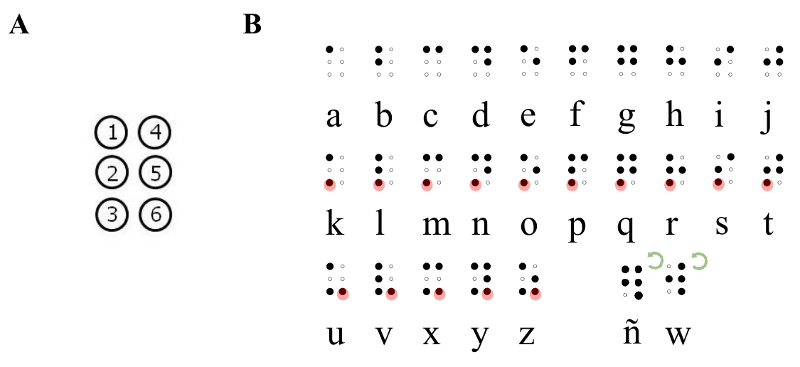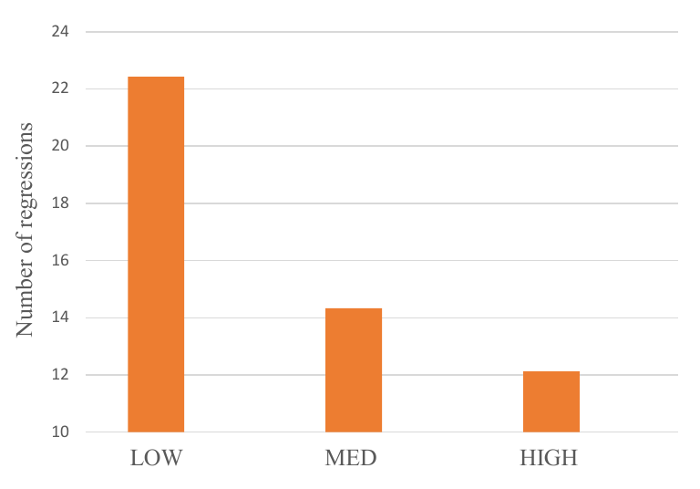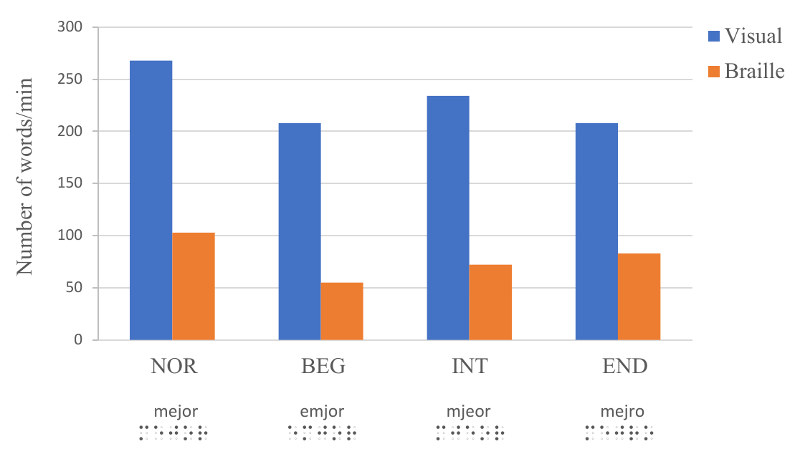Ana Baciero (a,b,c), Manuel Perea (b,c) y Pablo Gomez (a,b)
(a) Dept. of Psychology, DePaul University, EEUU
(b) Dept. de Metodología, Universitat de València, España
(c) Centro de Ciencia Cognitiva, Universidad de Nebrija, España
Reading, while usually done through vision, can also be done through touch using the braille system. Research on the differences between these two modalities is needed to distinguish between modality-dependent and modality-independent processes. This has theoretical implications regarding the improvement of our understanding of reading in general, and also practical implications: it may be useful to develop tools and strategies to better teach and learn braille, an essential skill to navigate the world for those visually impaired. Here, we describe two recent papers showing both similarities and differences between these two modalities.
Imagine a world in which words are not seen, but touched. This is the reality for more than 70.000 visually impaired people in Spain. Reading by the sense of touch is possible thanks to Louis Braille, who developed the braille writing system in 1824. Each letter in braille is formed within 2×3 matrices of dots named braille cells, where different combinations of raised dots form different letters (Figure 1).

Figure 1.- A) Braille cell and nomenclature of the dots. B) Braille alphabet: the first row has the base patterns; the second row is a replication of the first where dot 3 is added; the third row replicates the second adding dot 6 (additions highlighted in red). The letters “ñ” and “w” do not follow this pattern because they were added later. These two letters are rotations of the letters “q” and “r”, respectively.
Unfortunately, when it comes to braille use, there is somewhat of a paradox: technology such as audio books, which makes information readily available to blind readers, is replacing rather than supplementing braille, and hence the use of braille among the visually impaired population is declining (Rose, 2012). Furthermore, the misconceptions about this writing system can lead to negative attitudes towards learning it (Comisión Braille Española, 2015). Importantly, being fluent in braille is the gateway to inclusion: braille literacy is correlated with educational level, likelihood of employment, and income (National Federation of the Blind Jernigan Institute, 2009). Indeed, the unemployment rate among blind adults is around 70%, but it is substantially smaller (around 40%) for those individuals who can read braille (BrailleWorks, 2015; Ryles, 1996). Research on braille reading can improve current educational practices and help develop tools and strategies for teaching and learning braille. Furthermore, this research can help develop a more comprehensive theory of reading that discerns what processes are modality-independent (i.e., common to the visual and tactile modalities) and what processes are modality dependent.
Research on the visual modality of reading (i.e., printed reading) has led to a rich understanding of how we learn to read, and the psychological processes involved in such skill (Rayner, Pollatsek, Ashby, & Clifton, 2012). Recently, there is an increasing interest on studying reading through touch (i.e., braille). Investigating braille reading is challenging because: 1) the tools used in the visual modality cannot be easily adapted to the tactile modality; and 2) the population of expert braille readers is limited. Here we present two recent studies that have overcome these limitations and revealed interesting similarities and differences between printed and braille reading.
Let us begin with the similarities. Lei, Stepien-Bernabe, Morash and MacKeben (2019) examined how reading braille is affected by the physical quality of the written input: the height of the dots was standard or lower. When the dots’ height was low, braille readers increased the amount of backward hand movements when reading a text (Figure 2).

Figure 2.- Average number of backward hand movements while reading braille dots with low, medium, and high (i.e., standard) height in Lei, Stepien-Bernabe, Morash, and MacKeben (2019).
This pattern closely resembles the eye-movements of sighted readers when printed text has reduced brightness contrast (see Legge, Ahn, Klitz, & Luebker, 1997). More regressive movements reflect an increased uncertainty about the meaning of what they just read. On the theoretical end, this result implies that the influence of the input quality on reading appears to be modality independent. On the practical end, as modifications of the physical characteristics influence braille word recognition, these characteristics could be optimized to facilitate learning to read. For example, elements like the distance between braille cells and the size/height of the dots could be slightly changed to facilitate the recognition of words when learning braille or also as an adaptation tool for those with tactile sensibility loss.
There are also different patterns of results between visual and tactile reading. Perea, Jimenez, Martin-Suesta, and Gomez (2015) examined one of the most noticeable differences between visual and tactile reading. When reading a word, our visual system is capable of processing its constituent letters in a parallel manner, whereas our tactile system may have to process them more serially. Perea et al. (2015) compared braille and sighted reading of sentences with jumbled words vs. intact words (Figure 3). They found that, although both sighted and braille readers could understand the sentences with jumbled words, braille readers had a much higher reading cost than sighted readers. Furthermore, unlike sighted readers, the reading cost for braille readers was higher when the jumbled letters were at the beginning of a word.

Figure 3.- Average number of words per minute while reading printed (blue) and braille (orange) sentences with normal words (NOR), such as “ Fue el mejor momento de su vida”, or words with jumbled letters at the beginning (BEG), middle (INT), or end (END) in Perea, Jimenez, Martin-Suesta, and Gomez (2015).
Theoretically, these results suggest that encoding the position of the letters within a word depends on the characteristics of the sensory system that receives the information. On the practical side, the strategies and techniques to learn to read in braille should be different than those used to learn to read visually, at least regarding the basic stages that imply the recognition of letter positions in a word.
In sum, comparing visual and tactile reading has theoretical and practical implications since it reveals what reading processes are modality-dependent or modality-independent. Recent research has shown that the physical quality of words influences their recognition independently of the modality in which they are perceived, but letter position coding does depend on the constraints of modalities. Further research in this area will contribute not only to our understanding of reading but also to developing teaching strategies that will improve blind people’s literacy rates and, hence, their quality of life.
Referencias
Braille Works (2015). Braille Literacy is Vital to Academic Improvement and Employment. Recuperado de: https://brailleworks.com/braille-literacy-vital-academic-improvement-employment/
Comisión Braille Española. (2015). La Didáctica Del Braille Más Allá Del Código: Nuevas Perspectivas En La Alfabetización Del Alumnado Con Discapacidad Visual. Madrid: ONCE.
Lei, D., Stepien-Bernabe, N. N., Morash, V. S., & MacKeben, M. (2019). Effect of modulating braille dot height on reading regressions. PloS ONE, 14, e0214799.
Legge, G. E., Ahn, S. J., Klitz, T. S., & Luebker, A. (1997). Psychophysics of reading—XVI. The visual span in normal and low vision. Vision Research, 37, 1999-2010.
National Federation of the Blind Jernigan Institute (2009). The Braille Literacy Crisis in America: Facing the Truth, Reversing the Trend, Empowering the Blind. Retrieved from: https://www.nfb.org.
Perea, M., Jiménez, M., Martín-Suesta, M., & Gómez, P. (2015). Letter position coding across modalities: Braille and sighted reading of sentences with jumbled words. Psychonomic Bulletin and Review, 22, 531–536.
Rose, D. (2012, 13 febrero). Braille is spreading but who’s using it? BBC. Recuperado de: https://www.bbc.com/news/magazine-16984742
Ryles, R. (1996). The impact of braille reading skills on employment, income, education, and reading habits. Journal of Visual Impairment and Blindness, 90, 219-226.
Manuscript received on June 25th, 2019.
Accepted on July 30th, 2019.
This is the English version of
Baciero, A., Perea, M., y Gomez, P. (2019). Tocando tus palabras: Por qué la lectura braille es especial. Ciencia Cognitiva, 13:2, 50-53.

